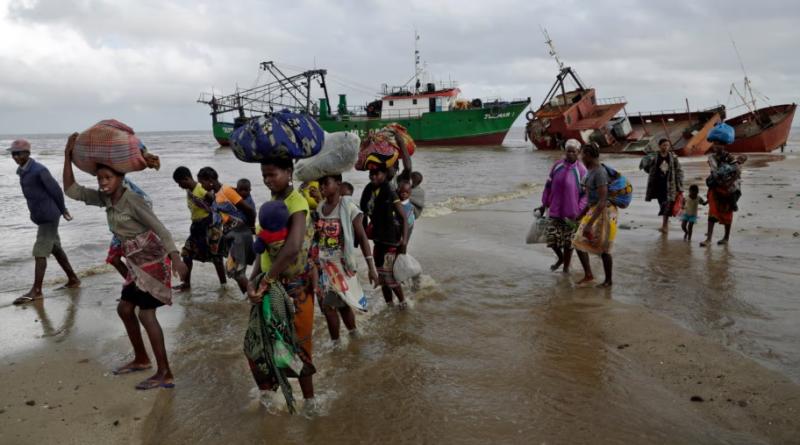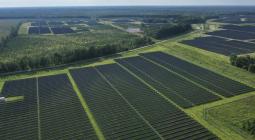At risk: 10 ways the changing climate is creating a health emergency

The lives of billions of people are being threatened by the climate crisis, experts from around the world warned in the annual Lancet Countdown report this week. No one will escape the consequences of climate change, but people living in poorer countries are particularly vulnerable. Here are 10 ways the climate crisis is affecting global health:
1. Floods and disease
As life becomes less tolerable for humans, animals and plants, things will get easier for disease-causing organisms. More than half of all known diseases have been made worse by the climate crisis, say scientists.
A warming world makes outbreaks of water-borne diseases such as cholera, dysentery, hepatitis A, typhoid and polio more likely. They spread when people eat or drink something that contains infected faecal particles, which is why outbreaks often happen where extreme weather events have damaged infrastructure and led to poor sanitation.
World Health Organization data published in September showed there were twice as many cholera cases in 2022 than in 2021. Outbreaks were recorded in countries where cholera had been under control for years, including Yemen and Lebanon.
Between February and March of this year, one of the strongest and longest tropical storms ever recorded displaced millions of people in five African countries. Cyclone Freddy lasted for eight weeks and travelled across Mozambique, Madagascar, Zimbabwe and Mauritius. Its worst effects were seen in Malawi, which was already battling its deadliest cholera outbreak when the storm hit.
Malawi recorded nearly 59,000 cases of cholera and 1,768 deaths by the time its health ministry said it had the outbreak under control in August.
2. Mosquitoes on the march
Rising temperatures and frequent floods also unlock new places where disease-carrying insects thrive. The mosquitoes that carry the viruses that cause dengue fever and malaria, for example, have more stagnant pools of water to choose from when laying their eggs. Floods may create new pools of standing water and droughts can shrink flowing streams into stagnant puddles. People are also more likely to store water during droughts, often creating ideal breeding grounds. Warmer temperatures even increase the rate at which mosquitoes bite people and how effectively the insects spread disease, say scientists.
Sudan experienced its worst dengue fever outbreak in 10 years in 2022, with heavy rains blamed. In Bangladesh, although dengue fever is common, the country recorded its biggest outbreak, with nearly 70,000 cases and 327 deaths between January and August this year. “The higher incidence of dengue is taking place in the context of an unusual episodic amount of rainfall, combined with high temperatures and high humidity,” the WHO noted. An outbreak of dengue has also been declared in Jamaica.
Nor is the disease confined to developing countries. There are fears that it is spreading in southern Europe, partly owing to the warm weather. More than 8 billion people could be at risk of malaria and dengue fever by 2080, scientists have warned.
3. Human-animal contact
Many existing diseases will get more dangerous, but new illnesses could also emerge as people are increasingly forced into areas where there is wildlife. Diseases can jump from animals to humans. These diseases, such as Ebola, avian flu and Sars, are called “zoonoses” and they make up the majority of new illnesses.
Scientists have found that the climate crisis is helping to circulate diseases between species that previously did not encounter each other. As the planet heats up, many animal species are forced to move into new areas to find suitable conditions.
It has been estimated that zoonoses are responsible for as many as 2.5bn cases of human illness and 2.7m human deaths worldwide each year, and that animals have played a major part in nearly every major disease outbreak since 1970.
4. Severe weather events
Although governments are getting better at preparing for severe weather events, nine out of 10 deaths linked to weather disasters since 1970 happened in small island nations and developing countries in Africa, Asia and South America.
Floods, drought, hurricanes and wildfires are becoming more frequent and putting vulnerable people at immediate risk. In September, Storm Daniel hit Libya, bringing catastrophic floods that killed an estimated 11,000 people, with thousands more still missing. Extreme weather disasters killed more than 18,000 people between the months of June and early September alone.
5. The air that we breathe
Outside air pollution has been linked to numerous cancers and diseases and is estimated to be responsible for more than 4m premature deaths globally each year.
Changing weather patterns are expected to make this already bad situation worse as more dust and wildfire smoke are added to the mix. Children are especially likely to get sick from air pollution because their brains, lungs and other organs are still developing.
When researchers scanned the brains of nearly 9,500 US children over a two-year period, they found that even small amounts of exposure to air pollution changed the way their brains developed, particularly in the region that controls emotions.
There are even signs that outdoor air pollution can make it more likely for people to develop type 2 diabetes, and that being exposed to four common air pollutants could also make people more likely to fall seriously ill or die as a result of diabetes-related complications.
6. The psychological cost
Environmental deterioration has a knock-on effect on the economic and social systems that keep society productive and happy, setting in motion a downward spiral of psychological hardship.
Research shows that wildfires, floods and heatwaves can cause anxiety, depression or post-traumatic stress disorder in the months following the event. In the long term, many adults are resilient in such crises, but children are more likely to carry these psychological effects into adulthood.
If crops are destroyed during extreme weather events, children may get less nutritious food, the consumption of which is linked to psychological conditions such as anxiety and depression.
When people can’t get the help they need, they may self-medicate with alcohol or drugs, which in turn makes them more likely to engage in risky behaviour (such as unprotected sex) that could result in infections such as HIV, or illnesses that can result from spending time in crowded places, such as tuberculosis.
7. Salty water and perilous pregnancies
Drinking water is becoming saltier. One reason for this is that sea levels are rising, so there is more sea water flowing into rivers and other sources of fresh water during floods and tropical storms.
Taking in too much salt can lead to high blood pressure (hypertension). Over time, this condition damages the body’s veins, arteries and major organs (including the brain, heart, kidneys and eyes) since they’re working so much harder overall.
Hypertension is doubly dangerous for pregnant women and their babies. In the coastal Dacope Upazila district of Bangladesh, researchers tested pregnant women’s urine and found they were getting up to 15g of salt each day through their drinking water alone (depending on where they got the water from). That’s triple the amount the WHO recommends. Another study in the same area discovered a link between salty drinking water and developing high blood pressure or pre-eclampsia. Nearly one-fifth of Bangladesh will be under water by 2050.
8. Food insecurity
More frequent and severe droughts and floods make it harder to grow the grains, fruit and vegetables that people need to eat to stay healthy. Small island states in the Caribbean, Atlantic, Pacific and Indian Ocean bear the brunt of the effects of the crisis, in part because most people live close to sea level.
On these islands, between 80% and 95% of the food on supermarket shelves is imported from elsewhere, and in the Caribbean, there’s some evidence to suggest that warehouses and supermarkets only have a month’s worth of stock available at any given time. There are few commercial farms on these islands and people have struggled to get agricultural projects up and running because of the likelihood of severe floods and destructive storms.
Imported foods tend to be highly processed and saltier, sweeter and unhealthier overall, causing high rates of non-communicable diseases (NCDs).
As a result, people who live in one of the 39 small island nations are the most likely to die from one of the four main NCDs: cancer, diabetes, heart disease and lung disease.
9. The stress of extreme heat
The scorching temperatures this year broke records in Europe, China and North America. Heat is one of the most dangerous effects of the climate crisis and the top cause of weather-related deaths in the US. One of the ways the human body keeps itself cool is by sweating, but there are limits to this function. When it gets too hot, the body’s temperature rises faster than it can cool itself down, less blood flows to other organs, and the kidneys have to work harder. This puts strain on the heart and can lead to organ failure. Heatstroke is the most serious heat-related illness.
In particular, people whose jobs require long hours of physical labour in the sun face an increased risk of kidney disease as temperatures rise, research suggests. Repeated instances of heat stress can lead to permanent damage and chronic kidney disease.
In June, the Guardian revealed how young migrant workers were returning to Nepal with chronic kidney disease after working in extreme heat conditions in the Gulf and Malaysia. “One factor highlighted again and again is heat. Prolonged exposure to heat and repeated dehydration,” Rishi Kumar Kafle, the director of Nepal’s National Kidney Center, said.
For people who live with chronic illnesses such as diabetes, the effects of heat stress can start much more quickly. When it’s hot, more people with diabetes are admitted to hospital with dangerously low blood sugar.
10. Millions on the move
It’s hard to predict exactly how many people will be on the move because of the climate crisis, but extreme weather events are likely to make conditions worse for the more than 100 million displaced people around the world. Many of these people have been forced to move countries by conflict and violence, but the Internal Displacement Monitoring Centre, an international NGO, says that climate disaster is a significant contributor to the rising numbers of people displaced within their own countries. Flooding in Pakistan in 2022 led to 10 million internally displaced people out of a record 71 million globally.
If nothing changes, the number of people who need humanitarian aid to recover from floods, storms and droughts could double by 2050, according to the International Federation of Red Cross and Red Crescent Societies.
That means more than 200 million people will need aid annually. The displacement of millions of people also means cramped and often unsanitary living. For example, more than 900,000 Rohingya refugees live in makeshift shelters in Bangladesh, often built on unstable ground that’s prone to landslides.
On top of the illnesses that already spike in the rainy season (such as dengue fever and malaria), frequent storms also make diarrhoeal diseases more likely.
Migration also makes it much harder to manage chronic illnesses such as cancer, diabetes and kidney disease.
Photograph: Tsvangirayi Mukwazhi/AP





